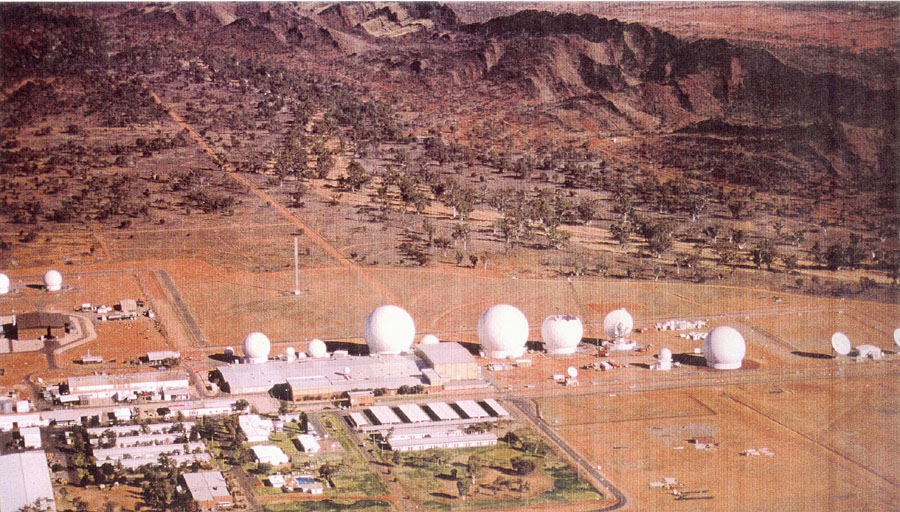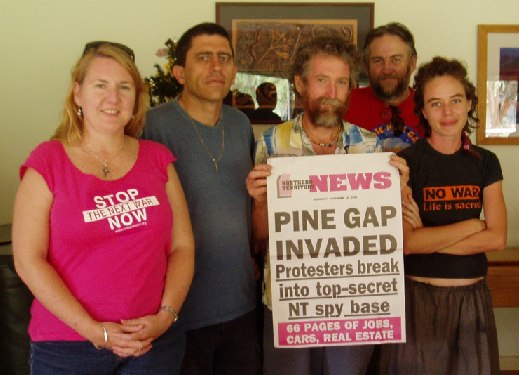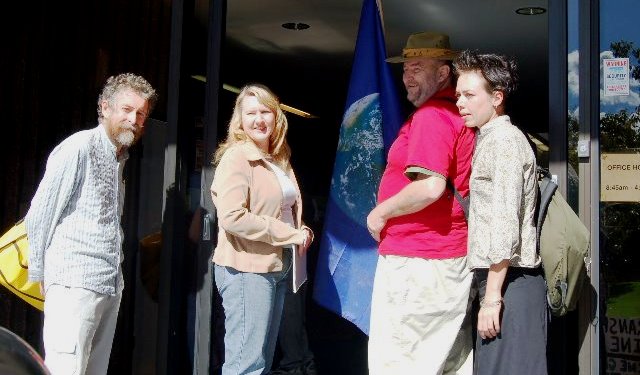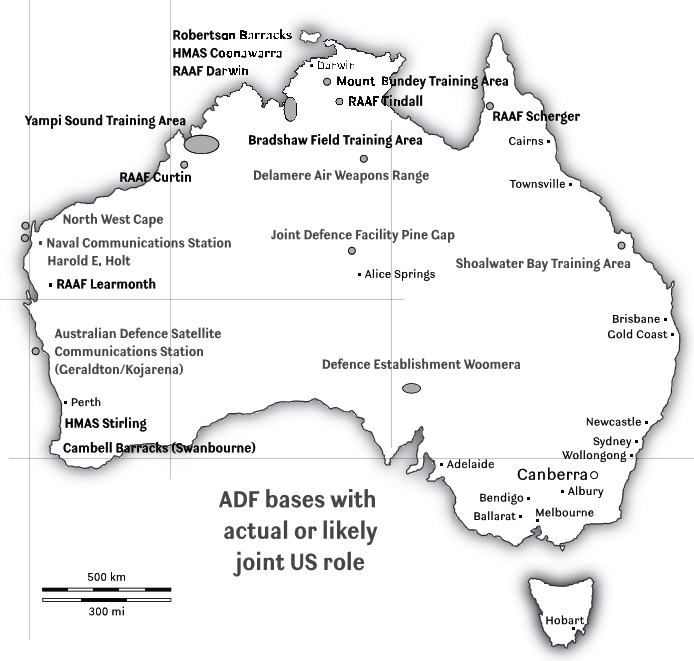#ClosePineGap 2016 – Alice Springs Peace Convergence (Australia) 19th Sep – 3rd Oct 2016
A national gathering of peace makers and anti war activists during the 50 Year Anniversary of Pine Gap. A series of independently organised events and artful non violent protest actions in and around Alice Springs. Themed on closing the U.S. spy and drone base at Pine Gap.
The ‘Joint Defence Facility Pine Gap’ is a satellite tracking station 18 kms south-west of Alice Springs. It consists of a large computer complex with eight radomes protecting antennas and has over 800 employees. It is believed to be one of the largest ECHELON ground stations.
 Pine Gap is controversial because it is an important element of the broader US-Australian military alliance and collaboration during wars such as those on Iraq and Afghanistan. Pine Gap is also an important element of the US-Australian nuclear weapons alliance (and related programs such as missile defence) and was a likely target for nuclear attack during the Cold War.
Pine Gap is controversial because it is an important element of the broader US-Australian military alliance and collaboration during wars such as those on Iraq and Afghanistan. Pine Gap is also an important element of the US-Australian nuclear weapons alliance (and related programs such as missile defence) and was a likely target for nuclear attack during the Cold War.
Academic Richard Tanter notes that “new operational capacities at the Joint Defence Facility Pine Gap outside Alice Springs, which brought the work of that facility to the front line in the wars in Iraq and Afghanistan and which, together with a new US space surveillance radar planned for North West Cape, have cemented Australia’s role in US missile defence and space operations.”
Protests over the years include:
- On 11 November 1983, Aboriginal women led 700 women activists to the Pine Gap gates where they fell silent for 11 minutes to mark Remembrance Day and the arrival of Pershing missiles at Greenham Common in Britain. This was the beginning of a two-week, women-only peace camp, organised under the auspices of Women For Survival. Women trespassed onto the military space and on one day 111 were arrested and gave their names as Karen Silkwood, the American anti-nuclear campaigner. There were allegations of police brutality and a Human Rights Commission Inquiry ensued.
- In 1986 the base was issued with an eviction notice to be “closed by the people” in a Close the Gap campaign; there was a protest by both women and men in which bicycles featured strongly.
- In 2002 about 500 people protested at the gates of Pine Gap, including some politicians. They were objecting to its use in the then impending Iraq war and missile defence, with a massive police presence. A few people were arrested after a scuffle with police.
- In December 2005 six members of the Christians Against All Terrorism group staged a protest outside Pine Gap. Four of them subsequently broke into the facility and were arrested. Their trial began in October 2006 and was the first time that Australia’s Defence (Special Undertakings) Act 1952 was used. In June 2007 the four were fined $3250 in the Northern Territory Supreme Court with the possibility of a seven year jail term. The Commonwealth prosecutor appealed the decision saying that the sentence was “manifestly inadequate”. The Pine Gap four cross-appealed to have their convictions quashed. In February 2008 the four members successfully appealed their convictions and were acquitted.
 Pine Gap is shrouded in secrecy. Federal Parliament’s Joint Standing Committee on Treaties noted in a 1999 report that: “To argue that elected representatives of the Australian community cannot be entrusted with any more information than has been provided to us during this review displays … profound disregard for the fundamental principles of public accountability that underpin our parliamentary system. The absurdity of this argument is highlighted by the fact that members of a good many US congressional committees are routinely allowed access to such information without apparent jeopardy to US national interests.”
Pine Gap is shrouded in secrecy. Federal Parliament’s Joint Standing Committee on Treaties noted in a 1999 report that: “To argue that elected representatives of the Australian community cannot be entrusted with any more information than has been provided to us during this review displays … profound disregard for the fundamental principles of public accountability that underpin our parliamentary system. The absurdity of this argument is highlighted by the fact that members of a good many US congressional committees are routinely allowed access to such information without apparent jeopardy to US national interests.”
 The International Campaign to Abolish Nuclear Weapons argues that Australia is in breach of its obligations under the International Covenant on Civil and Political Rights in respect of Nuclear Weapons in four ways: by supporting preparations for nuclear war carried out at Pine Gap; by allowing US nuclear-armed vessels to enter our waters; by relying on the “protection” of US nuclear deterrence; and by exporting uranium to nuclear-armed countries.
The International Campaign to Abolish Nuclear Weapons argues that Australia is in breach of its obligations under the International Covenant on Civil and Political Rights in respect of Nuclear Weapons in four ways: by supporting preparations for nuclear war carried out at Pine Gap; by allowing US nuclear-armed vessels to enter our waters; by relying on the “protection” of US nuclear deterrence; and by exporting uranium to nuclear-armed countries.
More information:
- Richard Tanter, “The ‘Joint Facilities’ revisited – Desmond Ball, democratic debate on security, and the human interest”, PDF: http://nautilus.wpengine.netdna-cdn.com/wp-content/uploads/2012/12/The-_Joint-Facilities_-revisited-1000-8-December-2012-2.pdf
- Nautilus Institute – detailed collection of links to information about Pine Gap: http://nautilus.org/publications/books/australian-forces-abroad/defence-facilities/pine-gap/
- Pine Gap protests: http://nautilus.org/publications/books/australian-forces-abroad/defence-facilities/pine-gap/pine-gap-protests/
- ‘Pine Gap Four’: http://pinegapontrial.blogspot.com.au/
- Australian Anti-Bases Coalition: www.anti-bases.org
- Back to the Bases, Richard Tanter, Arena magazine, May 2012, www.mapw.org.au/download/back-bases-r-tanter-us-forces-australia-may-2012
- Richard Tanter publications: http://nautilus.org/network/associates/richard-tanter/publications
- Richard Tanter, ‘Pine Gap and the coalition wars in Afghanistan and Iraq’, June 2007, Powerpoint: nautilus.org/wp-content/uploads/2011/12/Alice-meeting.ppt
- Medical Association for Prevention of War, resources on foreign bases in Australia: www.mapw.org.au/australian-issues/foreign-bases
- http://en.wikipedia.org/wiki/Pine_Gap
- Joint Standing Committee on Treaties, October 1999, ‘An Agreement to extend the period of operation of the Joint Defence Facility at Pine Gap’, www.aph.gov.au/Parliamentary_Business/Committees/House_of_Representatives_Committees?url=jsct/reports/report26/report26.pdf
[This webpage last updated August 2012.]

